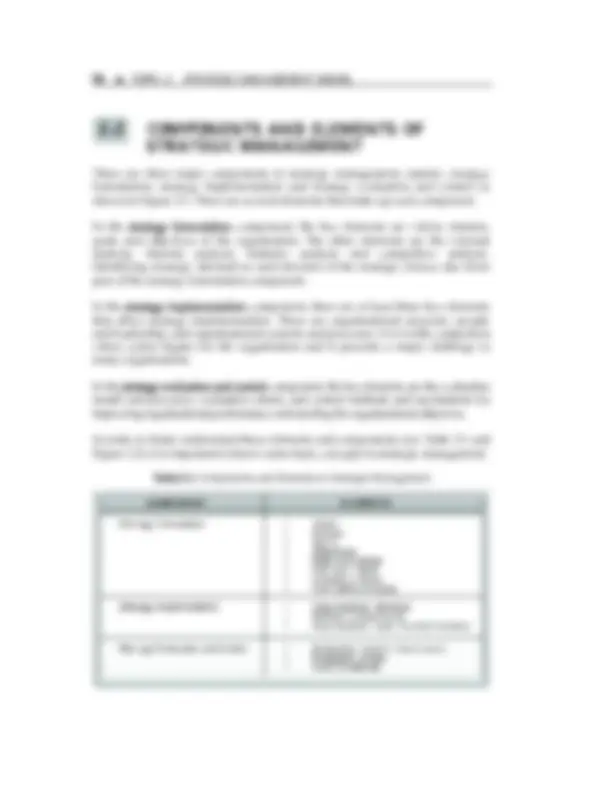






Study with the several resources on Docsity

Earn points by helping other students or get them with a premium plan


Prepare for your exams
Study with the several resources on Docsity

Earn points to download
Earn points by helping other students or get them with a premium plan
Community
Ask the community for help and clear up your study doubts
Discover the best universities in your country according to Docsity users
Free resources
Download our free guides on studying techniques, anxiety management strategies, and thesis advice from Docsity tutors
As mentioned in the earlier subtopic, the strategic management model comprises three parts, namely, strategy formulation, strategy implementation, and strategy ...
Typology: Lecture notes
1 / 8

This page cannot be seen from the preview
Don't miss anything!





Since the development of strategic management, there have been many definitions of strategic management as there are many books written in this area.
These definitions suggest the importance of decisions and actions to ensure organisational objectives are achieved.
Pearce and Robinson (1985) define strategic management as a set of decisions and actions that lead to the formulation and implementation of a strategy so as to achieve the objectives of the organisation.
According to Gluck and Jaunch (1984), strategic management refers to a set of decisions and actions that lead to the formulation of an effective strategy to achieve the objectives of the organisation.
By the end of this topic, you should be able to:
The later definitions by Hunger and Wheelen (1996) and David (2003) are consistent with the early definitions of strategic management, but added the elements of strategy formulation, strategy implementation, evaluation and control in the strategic management concept.
From the definitions, it is clear that strategic management involves making decisions and taking actions that can help organisations achieve their objectives by adopting a systematic way of formulating the strategy, implementing the strategy, and evaluating and controlling the strategy implemented. Strategic management, therefore, integrates various functional areas like marketing, management, finance, accounting, human resources, production and information systems in a formal and systematic manner consistent with the objectives of the organisation and superior performance. This definition also suggests that strategic management comprises three key components, namely, strategy formulation, strategy implementation and strategy evaluation and control as shown in Figure 2.1.
Figure 2. 1 : Strategic management model
In subtopic 2.2, you will be exposed to the fundamental elements and components of strategic management. Subtopic 2.3 discusses the strategic management model and subtopic 2.4 discusses the strategic management process.
David (2003) defines strategic management as the art and science of formulating, implementing and evaluating cross-functional decisions that enable an organisation to achieve its objectives.
Hunger and Wheelen (1996) define strategic management as a set of managerial decisions and actions which determine the long-run performance of an organisation. It also includes environmental scanning, strategy formulation, strategy implementation, and evaluation and control.
For example, Yahoo's strategy is to obtain 80% of its revenue from advertising to obtain more revenue from customers who pay for services. As such, YahooÊs strategy is to offer services like personalised Web pages, audio subscriptions and music videos for a fee (David, 2003). Strategists are, therefore, people in the organisation who are responsible for the success or failure of the organisation (David, 2003). They are also people who can make key decisions affecting the survival of the organisation. These are people with job titles like the chief executive officer, vice-chancellor, president, executive director, managing director, dean, chairman of the board and business owner or entrepreneur.
Another familiar term in strategic management is policy. Policies include guidelines, rules and procedures that were established or created to support the efforts in achieving organisational objectives. Policies provide broad guidelines for managers to operate their business activities without indicating the specific approaches or ways of doing things. In order to know how to do things, procedures and rules are developed so as to ensure consistency in the way things are done. For example, the policy of an organisation is to give a performance bonus of four monthsÊ basic salary to employees with excellent performance. The organisation has found that 10 of its 100 employees deserve this performance bonus, and to implement this policy, the human resource department is required to determine the criteria for excellent performance (which is generally defined in the performance appraisal process), and then apply the rule to the affected employees. Procedures will explain how things should be done, while rules will explain what would be done within the parameters set by the organisation. So the rule is that only excellent employees will receive the four monthsÊ bonus. The procedure is outlined in the annual performance appraisal evaluation form as set out by the human resource department.
The term ‰strategy„ refers to the means by which organisations try to achieve their long-terms objectives (David, 2003). It also refers to the actions that managers have to take or do in order to ensure that what has been set in the objective can be achieved.
Figure 2. 2 : Strategic management model
In implementing strategy, the organisation has to make sure that the elements in implementation are in place. This means that the organisational goals have to be defined at the operational level, and translated into objectives, which are more specific and precise than the goals set by the organisation. Policies in the organisation need to be developed and put in place. Then, specific programmes or plans of action should be prepared to ensure effective implementation of the organisational strategy. Strategy implementation would not be complete without ensuring that the fundamental elements in strategy implementation are all in place. This includes ensuring that the organisation has the appropriate structure, people and leadership required to manage the implementation of the selected plan of action. Finally, implementation also requires managers or strategists to coordinate and integrate the various functional areas in the organisation so that the systems and processes of managing the various multifunctional areas are synchronised with the organisational objectives that have been set earlier.
The final part of the strategic management model comprises strategy evaluation and control. In this component, managers or strategists have to ensure that the implemented strategy is evaluated accordingly and reviewed periodically, say every half yearly or quarterly. The evaluation criteria and expected performance are benchmarked with the standards of the industry or firm. Comparisons are made with other competitors or firms or in time dimension (against the previous year). Control mechanisms should be put in place so that organisations can assure that the desired objectives set can be met in the next phase of implementation.
Once the strategic management model is clearly defined and set, the next phase involves understanding the processes of strategic management.
Based on Figure 2.2, it can be concluded that the strategic management model is an interactive process. In other words, in trying to operationalise the strategic management model, managers or strategists have to make sure that they must begin the process by determining the vision of the organisation. The mission of the organisation must also be clarified. Then, the organisational goals are defined and set by the managers or strategists.
Operationalising the strategic management model involves a series of steps that are continuous and ever changing with the dynamics of the environment. A change in one of the elements can affect the other elements in the strategic management model. Thus, the strategy formulation, implementation, evaluation and control must be done on a continual basis and not a one-time approach. For example, in a situation where the organisation has already set its vision, mission
and goals to be achieved, the process of strategy formulation begins by analysing the strategic situation of the organisation. In other words, analysing the external environment, organisational strengths and weaknesses, and industry analysis (and/or competitive analysis) should be the first stage in the strategic management process.
Of course, organisations can also review their goals consistent with the ever changing business environment so that the organisation would not remain less competitive. For example, in an airline industry, the organisation may set its mission to be the leader in the airline services industry. However, the airline industry landscape is changing fast and not only provides airline services but also other related services like hotel, tourism, holiday packages and even car rentals. As rivalry within the industry becomes more intense, redefining the organisational mission becomes inevitable and a necessity to ensure that the organisation continues to survive in the hostile environment.
At the implementation phase, the strategic management process may begin by reviewing the organisational structure and people available in the organisation before setting the policies and programmes or plans of action. The organisational systems and processes may also have to be revised accordingly. Consequently, the strategy implementation process may differ under different circumstances and situations.
Finally, at the strategy evaluation and control phase, the process may require organisations to review the control mechanisms more than the strategy evaluation processes.
Since the strategic management model is a dynamic process and requires constant updating and reviews, the process of strategic management practice can be as fluid as the rapid changes in business dynamics. At this stage, it should be realised that there are, however, several key aspects which do not change despite being fluid in the practice of strategic management. The first is the key elements in the strategic management component, and the second is the three major components of strategic management. These two aspects do not change as long as the concept of strategic management is defined in a manner mentioned earlier in this topic.
How do changes in the business environment affect strategic management?